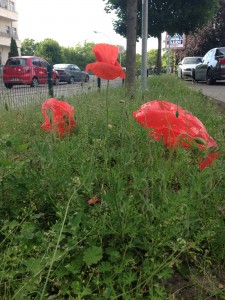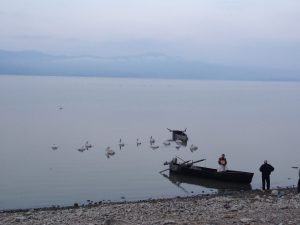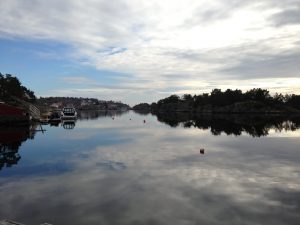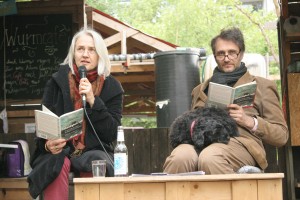The Enlivenment Manifesto: Politics and Poetics in the Anthropocene

Key Concepts
- The current ideology of dead matter, mechanical causality, and the exclusion of experience from descriptions of reality in ecology and economy are responsible for our failure to protect aliveness in our world.
- The challenge of the ‘Anthropocene’ and the end of dualistic enlightenment-style thinking is to install a new ‘bios’ into our concept of reality, putting aliveness, the world as a living process of mutual transforming relationships, subjectivity, and expression, at its center: an ‘Enlivenment’ view.
- The scope of the ‘Enlivenment’ perspective equals the shift in modern physics realizing that any observer is entangled with the system being observed. Biological entanglement happens emotionally and experientially through sharing aliveness with and relating existentially to other living subjects.
- Findings in the life sciences, particularly in biosemiotics, cognition research, and developmental biology, show that it is necessary to view organisms as goal-directed agents, who bring meaning and experience into the world as physically relevant powers.
- We need a ‘policy of life’ as a new political-philosophical attitude to make ‘deep sustainability’ possible. It will supplant the idea of reality as iteration of ‘empirical facts’ by an ‘empirical subjectivity’ of shared aliveness and a ‘poetic objectivity’ of describing and practicing relatedness and mutual transformation.
Enlivenment in Brief
Enlightenment thinking is coming to an end. The ‘Anthropocene’ claims to step beyond the dualism of man-nature opposition. Culture is everywhere. This might be an opportunity for sustainable action: Saving nature becomes a cultural endeavour. However, the salute to anthropocene stewardship masks the silent enclosure of life within technoculture and bioeconomy. Civilization still operates as if reality is about organizing inert, dead matter in efficient ways. It is impossible to achieve sustainablity with our prevailing ‘operating system’ for economics, politics, and culture if the underlying ‘bios’—our unconscious assumption about reality—remains tied to an ideology of dead matter. On a profound level, nature is threatened by ignoring the principles of fertile, imaginative interpenetration, which shape existence. The real opportunity of the ‘Anthropocene’ is to create a new bios for our thinking—an Enlivenment. This means to understand that man and nature pertain to a reality creating embodied processes of transformative relationships, expressive meaning, and true inwardness in biological subjects. The scope of the ‘Enlivenment’ perspective is comparable to the shift in modern physics which realized that any observer is entangled with the system being observed. Biological entanglement happens emotionally and experientially through shared aliveness with other living subjects. The according ‘policy of life’ strives for a civilization in which institutions and economic practices follow the maxim that life shall be. A policy of life struggles to liberate subjects from the colonization by the ideology of dead matter, granting them the right to embodied agency and to meaningful experience. This is not easily achieved, as it requires a deep change in our perception of reality. The ‘bios’ of ‘Enlivenment’ will require a long-term commitment comparable to the struggle for universal human rights.
Dualism Has Ended
You do not have to be good.
You do not have to walk on your knees
for a hundred miles through the desert repenting. You only have to let the soft animal of your body love what it loves.– Excerpted from ‘Wild Geese’ by Mary Oliver
A ground-breaking new vision of humankind is quickly spreading into the mainstream of our self-understanding. We are no longer standing apart from nature, so the new belief goes: We are enmeshed in it. Some authors even assert that nature and humans are one and the same.1 This comes not just as a philosophical claim but rather as an empirical realization. The cultural image man has of himself has become a scientific issue. Traces of pesticides, nuclear fallout, and nitrogen fertilizer can be found in the Arctic ice crystals and in the soils of the Amazon. Climate change has proven that humans are inescapably connected to Earth and its systems.
These are the signs of the ‘Anthropocene,’ or, as some call it, the geological ‘epoch of humankind.’ ‘Anthropocene’ was first coined as a geological term by atmospherical chemist Paul Crutzen.1 He argued that the extent of human domination over the biosphere has abrogated the idea that nature is separate from humans, thus ending the Holocene.
We still need to fully realize that the change in the geologic calendar named by Crutzen has heralded a distinctly new cultural epoch. In this new age, which has just begun, nature and mind are no longer separate. The duality between nature and culture, which stems from Enlightenment thinking, has been overcome, and this is big news. Dualism, which determined our thinking and actions for 250 years, has ended. The Enlightenment is over.2
Technology and science have ironically overcome their dualism through an obsessive insistence of it. Our civilization long believed that the Earth was an object separate from the human. In doing so, it has unwittingly proved the opposite.
In one respect, we should feel relieved. The split in our thinking that opens between nature conceived as soulless resources and human agents as the rational actors was what started the ongoing environmental catastrophe, which includes global warming and the current ‘sixth extinction’ wave of species loss.3
Many claim that the starting point for a new idea of sustainability and nature protection lies in the Anthropocene. Because nature and culture are supposed to be one, humans therefore should become responsible for the Earth-system. As the argument goes, humans must become stewards for the whole natural-cultural Earth because they have totally infiltrated it.4 Sustainability from this perspective is thought to be a more attractive and convincing concept: it no longer means protecting the ‘other,’ but cultivating ourselves.
An Old Fallacy with a New Fascination
And when two people have loved each other see how it is like a
scar between their bodies, stronger, darker, and proud;
how the black cord makes of them a single fabric that nothing can tear or mend.– Excerpted from ‘For What Binds Us’ by Jane Hirshfield
Relief, however, is not due. The reconciliation between humans and nature, which is held by many who favor the Anthropocene viewpoint, takes place as a universal victory of culture, negating the possibility to understand and protect life and aliveness. What is saluted as the end of dualism is a hidden new self-aggrandizement of humankind, an attitude that again threatens to convert nature into a project of cultivation and control. Psychologists call such a situation a ‘double bind,’ that is, to assert something but to do the opposite.
The philosophers Max Horkheimer and Theodor W. Adorno had pointed out this blind spot 70 years ago when criticizing Enlightenment-style thinking at the time. Horkheimer and Adorno claimed this thinking to be as ‘totalitarian as any system’ and argued that its ‘untruth’ lies in the fact that ‘the outcome is decided from the beginning. The world-rulership over nature turns against the thinking subject itself.’ Horkheimer and Adorno wrote their analysis more in the first half of the last century. But has the situation really changed?5
Leading proponents of the Anthropocene still interpret connections as ‘distinction-and-domination,’ and reconnecting with other living beings is performed as a dominance of humans over everything, even over ourselves. If all life is understood as culture, human superiority over nature has not ended. Instead, the human sphere has pervaded nature by a sort of hostile takeover.6
Many proponents see the Anthropocene as revolutionary change. But much of its concepts thoroughly clutch to industrial modernism in the image of Homo faber, which controls nature by technical means. Current thinking increasingly emphasises all agency’s artificiality and ‘createdness.’ The ‘cyborg,’ even the ‘monster,’ has become an often-used metaphor to understand our relationship with reality.7

spring day at the Norwegian south coast near Kristiansand.
Though the bias toward technical control has superficially changed its face, it has endured in the depths, leading to an overall celebration of ‘hybrid structures’ that reflects a profound bias towards the human-created artifact, such as consciousness enhanced by data interfaces, or ecosystems that have multiple roles as species museums and high-yield agricultural fields.
The idea of the Anthropocene as an epoch of humankind is giving new force to ideologies of objectification, manipulation, and control, whose true scope hides behind optimism and the ‘cool’ rhetoric of communal eco-technological endeavours and ‘win–win’ situations. In the wake of such marketing, industrialized countries are able to abuse the myth of a reconciliation between nature and technology in order to advance profit-oriented bio-economics, exploit global technology markets, and reify the economic and agrotechnological predominance. As has long been observed, such a move is even exemplified in the very term sustainability: from its origins as an eco-social concept, it has since mutated into a mere advertizing catch phrase.
Even the ‘green economy’ is stuck in this attitude. The monetization of nature, and the creation of leveraged financial instruments from ‘ecosystem services,’ has put the green economy on the path toward privatization and scarcity, thereby obscuring the subjective dimension of living nature, and taking away a community’s right to enter into meaningful relationships with their environment.8
If we believe that humans and nature can only be reconciled when technology dominates the Earth, and if we could admit presumed reconciliation, because we now have convinced ourselves that nature always carries a cultural stamp, we are prevented from seeing that every material exchange transforms the imaginative space of this world. We still disregard the interior and meaningful dimension of everything alive.9,10
Toward More Aliveness

of the catch.
Ye blessèd creatures, I have heard the call Ye to each other make; I see
The heavens laugh with you in your jubilee My heart is at your festival.
My head hath its coronal,
The fulness of your bliss, I feel—I feel it all.– Excerpted from ‘Ode: Intimations of Immortality’ by William Wordsworth
Most of the problems of our culture have a common origin: We view reality as dead. The economic, political, and educational mainstream see a world made of simple, nonliving building blocks. We can be enhanced—without limit—by analyzing the underlying elements and reconstructing them using technological, economic, or ecological means.11,12
However, scientists increasingly understand reality as a meshwork of mutually transformative and meaningful relationships, which are experienced by subjects. From this vantage point, creativity and poetic expression, which since historical modernity was previously only reserved for the cultural sphere, become fundamental elements of reality.
This approach is not utopian. It is starting to find root in the current revolution of biological thinking, similar to the revolutions in physics roughly 100 years ago through relativity theory and quantum physics. Humans and nature are one, because creative imagination and feeling expression are natural forces—the only way to unite the lone spheres of matter and culture.9,11
We can, however, observe a dialectics coming to our rescue, which Horkheimer and Adorno would never have seen coming when formulating their Dialectic of Enlightenment. 5 Insights gained in the natural sciences have forced us to reconnect rational understanding with a practice of imaginative aliveness. It is natural science, which by applying its rule of empirical objectivity, finds its opposite—meaningful subjectivity—in the depths of the unfoldings of the biosphere. In the findings of empirical biology, which pursue the semiotic approach, living beings are no longer understood as machines but as subjects bringing forth meaning.

Subjective experience is rooted in matter as the way biological organization is only possible.10-13 After the Enlightenment, we therefore need to work towards an ‘Enlivenment’ that is able to close the gap between subjective experience and objective description.14
This attitude can counter our fixation with techné—analysis and reconstruction—and shift our attention to poiesis—our embodied symbolical imagination with its existential experiences of lived values. When we pay tribute to poiesis, we understand life as a phenomenon in which matter reveals a tendency of generating individuals that can self-produce and self-maintain, thereby giving them a meaningful standpoint.
Because we are part of this creative meshwork of relations, we can gather knowledge of it, not as a measuring device would, but in a way comprehensible to living beings. The ‘truth of nature’ (as opposed to the ‘untruth’ of the totalitarian system of a reality colonized by a dualist view Horkheimer and Adorno had analyzed so deeply) lies in nature’s creative openness that constantly gives life, or ‘healing.’
To preserve the biosphere, we need to focus our actions on the image of a living reality. We need to conceive a new ‘bios.’ On the most profound level, nature is threatened not only by the disruption of bio-geo-chemical circulation and species balances, but also by ignoring the principles of fertile, imaginative interpenetration, which shape our existence. Traits of this threatened but necessary aliveness are openness, diversity, potentiality, the exchange of gifts, transformation, and the existential paradox of isolation and unity.15,16
Experiencing the world as alive helps us to rethink our relationships to other humans, to other beings, and to matter. We can stop fashioning these connections into a means of exploiting resources. We will only decently survive the Anthropocene by realizing that humans not only pervade nature but consist of something not consciously made by man: a self-organizing aliveness profoundly enmeshed with ecosystems in terms of metabolism and metaphor.
The creative power inherent in reality cannot be turned off. To misjudge or disregard it, as we have done and continue to do, is dangerous and ultimately destructive for life. Ignoring reality always will generate violent encounters with it. Therefore, the most important task in the Anthropocene is to rethink and regenerate aliveness.
What Humankind Can Be
may my heart always be open to little
birds who are the secrets of living
whatever they sing is better than to know
and if men should not hear them men are old-by E.E. Cummings
A future for humankind based on ecological and social justice is only possible if we emphatically renew our specifically human manifestation of what constitutes embodied existence: the middle ground where aliveness and creativity seek to experience themselves. We can call these qualities ‘soul,’ ‘heart,’ the ‘spiritual nature of man’ (Erich Fromm),17 or the irreducible and indefatigable ‘wild’ (Gary Snyder).18 These form the basis of everything alive and are enacted by us in a particular human cultural fashion.
Such an understanding of humanness-as-aliveness relies on the possibility of finding a specifically human interpretation of aliveness. We can therefore never be entirely reconciled with living reality. Any such belief, which claims to have found a shortcut to the exhausting negotiations, pitfalls, and creative improvisations of being subject-in-relation, implies a new utopian version of control. We, however, do not need another impossible Utopia but must acknowledge our creative fragility. Only through this are we coupled to an infinite capability for living imagination and always open to healing.14
There already exist many sources from which the position of Enlivenment can find inspiration and support in its philosophical, economic, social, and scientific dimensions, such as the ‘capability approach’ of Amartya Sen and Martha Nussbaum;19,20 Manfred Max-Neef ‘s ‘barefoot economics’ grounded on human needs;21 and Albert Camus’ pensée du midi, a self-limitation based on poetic and sensual experience, which the French philosopher called the ‘Mediterranean spirit.’22
We can see the attitude needed already in practice in the economy of the commons proposed by Silke Helfrich,23 David Bollier,24 and Nobel-Prize-winning economist Elinor Ostrom;25 in the ‘dialogics’ of philosopher Edgar Morin;26 in Lewis Hyde’s ‘circle of the gift;’27 in the poetic biophilosophy of the ‘Biogea’ vision developed by Michel Serres;28 and in the enlarged understanding of art in the wake of Joseph Beuys, who proposed artistic expression starts with acknowledging and liberating one’s own aliveness.29,30
Science as a Practice of Empathy
As the crickets’ soft autumn hum is to us
so are we to the trees as are they
to the rocks and the hills.Excerpted from ‘Frontline’ by Gary Snyder
The scientific community has a crucial task of re-shaping the relationship between humankind and the remainder of creation. Climate change has demonstrated how scientific methods are indispensable in the search for new ecological standards, and these methods have always shown our interrelatedness with nature, even when we believed otherwise.
Meanwhile, throwing more and better scientific techniques to resolve all open questions has proven futile. What we can ‘know’ has structural restrictions—reality is not a closed system. We are giving up the idea of a biology that follows linear and objective laws, like in Newtonian physics. In biology, as analogous to quantum physics, the researcher is entangled with his research subject, although this entanglement is not quantum but experiential. Both are alive and connected in an emotional relationship.9,14
If reality cannot be objectified, a value-free and neutral science is not possible. Our conception of the world determines how we treat it and how it changes. Accordingly, any position that assumes an objective, timeless, and value-free description of reality or a part of it is a violent self-authorization. Any seemingly neutral and presumably objective attitude cements invisible structures of power. Knowledge is not objective when produced in this manner; it is valid predominantly in the sense that it stabilizes the system from which it arose.
Any knowledge is already an implementation of certain standards of treating the world and each another. The task of living together on this planet therefore requires being attentive not only towards theory, but also toward scientific practice. When does science only produce results to satisfy the inner demands of a knowledge industry? When does it legitimize political, economic, or technological interests? We need to carefully scrutinize all reifications of scientific thinking and refrain from them in order to help science become more an authority that serves the unfolding of aliveness and helps humankind develop a self-understanding as selfood-in-connection.30
In the Anthropocene, any form of science must consciously incorporate its particular values and interests, as well as explicitly naming them. It must reflect on its inevitable entanglement and creatively work upon it. Instead of producing merely functional knowledge, science should also focus on meaningful orientation, thereby carefully observing the world not from the perspective of a cybernetic system, but also as a meshwork of relationships with the power to bring forth aliveness. Through this, a culture of meaningful connection between humans and the remainder of creation can arise. It can be conceived as an art of embodied consciousness, as an ecological ‘Art of Living.’
Toward a Policy of Life
For what else have stones been shaped
but to prolong the human presence and to say
soundlessly in lost tongues:
We loved the earth but could not stay?– Excerpted from ‘Little Treasures’ by Loren Eiseley
In the Anthropocene, sustainability can only be meaningfully reconceived through the perspective of ‘Enlivenment.’ We need to be devoted to ‘cultures of aliveness’ to enable truly sustainable behavior.31 Unfolding cultures of aliveness is an epochal political project. It is a vision of civilization going beyond day-to-day crisis management and the ‘flight mentality’ of current politics.
Let us call this vision a ‘policy of life.’ A policy of life strives for a civilization in which principles, institutions, and economic practices follow the maxim that life shall be. Such an ethos cannot be achieved in the short term. It requires a commitment comparable to the struggle for universal human rights, which unfolded in the centuries since the original Enlightenment idea had gained traction. This time it needs to be a strife to create a solidarity-in-being among all living subjects.
The political agenda of the Enlightenment was intended to elevate humankind from its incapacitation by granting it rational agency. A policy of life (Enlivenment) enlarges this struggle to a more comprehensive goal: liberating the feeling and creative human from the colonization by an ideology of dead matter, granting it the right not only to rational but also to embodied agency, and to meaningful experience.
A policy of life preserves the necessary Enlightenment values— such as individual dignity, justice, and equality—while reconnecting them with their roots that rest in the co-creativity of everything alive. It does not substitute rationality with life but regards it as the quest to unfold a culture that is aware of, and responsible for, the potential imaginative aliveness in all living things.
A policy of life searches for alternatives to the dogma of growth and addiction to consumerism. It does not seek technological control but pursues the creative negotiation between equal participants in an ecosystem that all need to preserve. It strives to promote the experience of aliveness. It creates economic productivity through ecological stability and meaningful actions.32
A policy of life strives for the following:
- A global ecological agriculture, which secures yields by enhancing biodiversity and human existential experiences (meaning and joy); which integrates and does not separate.
- An economy that does not support the ‘use’ of resources in a ‘market’ built on ‘objectivity’ and separation but enlarges the possibilities to participate in a shared planetary metabolism of commons economy and is guided by an understanding of economic exchange as the shared household of the biosphere.
- A culture that no longer functions according to the income-generating model of private economics but participates in a cocreative process of production.
- A biology that understands organisms not only as ecosystem-service providers and molecular toolboxes but also as creative subjects, and which sees humans as a metabolic part of a biosphere enmeshed with life and feeling.
- An education that teaches an Art of Living and Connection; that does not follow only a standard of abstract knowledge, functionalistic technology, and ‘dead world’ thought; that reduces valuations and judgements.
- A policy that understands regional administrative entities as self-organizing commons and does not follow rules of universal abstraction and selfish market interests.
- A shared livelihood with other beings in line with the South American creation ethos of ‘Buen Vivir’ or the idea of ‘Conviviality’ by Caillé et al., that is, a solidarity of existence with all beings.33,34
- A regenerative transformation of the fractures and contradictions inherent in any connection, creation, and in life itself, in line with a bravery of being and an imaginative practice of aliveness with ‘manners, grace and style’ (Gary Snyder).18
A policy of life makes explicit what implicitly keeps us alive while actively nourishing it. It is pluralistic, dialogical, and mediating. It understands reality as a commons in which all beings co-creatively partake. It assumes responsibility for reality and supports us on the way to ourselves, acknowledging that this way is never achieved and can only be laid down by walking. Only when our new loyalty with everything alive becomes our cultural desire, the Anthropocene will truly merit the name of the ‘time of humankind.’
GLORY be to God for dappled things—
For skies of couple-colour as a brinded cow;
For rose-moles all in stipple upon trout that swim; Fresh-firecoal chestnut-falls; finches’ wings;
Landscape plotted and pieced—fold, fallow, and plough; And all trades, their gear and tackle and trim.Excerpted from ‘Pied Beauty’ by Gerald Manley Hopkins
Note: The Enlivenment Manifesto was published in Solutions Magazine 12/15.
Acknowledgments: Heartfelt thanks to Carsten Jasner, Myriam Kentrup, and Gerburg Rohde-Dahl for valuable in-depth discussions and helpful suggestions to improve previous versions of the text. Many thanks also to Celeste Ceguerra who did her usual eloquent native-language copy editing. We are grateful for valuable suggestions by the reviewers. The work was funded by grants from the Cocreation Foundation for Collaboration and Collective Development, Kairos Foundation, and Selbach Foundation for the Environment.
Endnotes
1 Crutzen, P.J. and E. Stoermer. The ‘Anthropocene’. Global Change Newsletter 41, 17–18 (2000).
2 Sepahvand, A., C. Rosol, and K. Klingan. in Grain, Vapour, Ray. Textures of the Anthropocene (eds Sepahvand, A., C. Rosol, K. Klingan, and B.M. Scherer) Introduction, 7–42 (MIT Press, Cambridge, 2014).
3 Kolbert, E. The Sixth Extinction. An Unnatural History (Bloomsbury, New York, 2013). 4 Marris, E. Rambunctious Garden. Saving Nature in a Post-Wild World(Bloomsbury, New York, 2013).
5 Horkheimer, M. and T.W. Adorno. Dialectic of Enlightenment (Verso, New York, 1997).
6 Shellenberger, M. and T. Nordhaus (eds). Love Your Monsters. Postenvironmentalism and the Anthropocene (The Breakthrough Institute, Oakland CA, 2011).
7 Ferrando, F. Posthumanism, Transhumanism, Antihumanism, Metahumanism, and New Materialisms. Differences and relations. Existenz 8, 26–32 (2013).
8 Crist, E. On the poverty of our nomenclature. Environmental Humanities 3, 129– 147 (2013).
9 Weber, A. The Biology of Wonder. Aliveness, Feeling, and the Metamorphosis of Science (New Society Publishers, Gabriola Island BC, 2016).
10 Weber, A. and F.J. Varela. Life after Kant. Natural purposes and the autopoietic foundations of biological individuality. Phenomenology and the Cognitive Sciences 1, 97–125 (2002).
11 Hoffmeyer, J. Biosemiotics: An Examination Into the Signs of Life and the Life of Signs (University of Scranton Press, Scranton PA, 2009).
12 Deacon, T. Incomplete Nature. How Mind Emerged from Matter (Norton, New York, 2012).
13 Kull, K. Semiosis stems from logical incompatibility in organic nature: why biophysics does not see meaning, while biosemiotics does. Progress in Biophysics and Molecular Biology (2015)http://dx.doi.org/10.1016/j.pbiomolbio.2015.08.002.
14 Weber, A. Enlivenment. Towards a Fundamental Shift in the Concepts of Nature, Culture and Politics (Böll, Berlin, 2013).
15 Weber, A. Lebendigkeit. Eine erotische Ökologie (Kösel, München, 2014).
16 Weber, A. in The Wealth of the Commons: A World beyond Market and State (eds Bollier, D. and S. Helfrich) Ch. 1, 6–12 (Levellers Press, Boston, 2012).
17 Fromm, E. To Have or To Be (Bloomsbury Academic, New York, 2013).
18 Snyder, G. The Practice of the Wild. Essays (Counterpoint, Berkeley, 1990).
19 Sen, A. The Idea of Justice (Penguin, London, 2010).
20 Nussbaum, M. Upheavals of Thought: The Intelligence of Emotions (Cambridge University Press, Cambridge, 2013).
21 Max-Neef, M. and P. Ekins (eds). Real Life Economics: Understanding Wealth Creation (Routledge, London, 1992).
22 Camus, A. The Rebel: An Essay on Man in Revolt (Vintage, London, 1992).
23 Bollier, D. and S. Helfrich (eds). The Wealth of the Commons: A World beyond Market and State (Levellers Press, Boston, 2012).
24 Bollier, D. Think like a Commoner. A Short Introduction to the Life of the Commons (New Society Publishers, Gabriola Island BC, 2014).
25 Ostrom, E. Governing the Commons: The Evolution of Institutions for Collective Action (Cambridge University Press, Cambridge, 2015).
26 Morin, E. La méthode: Tome 5, L’identité humaine, l’humanité de l’humanité (Seuil, Paris, 2001).
27 Hyde, L. The Gift: Creativity and the Artist in the Modern World (Vintage, London, 2007).
28 Serres, M. Biogea (Univocal, Minneapolis, 2012).
29 Beuys, J. In Kunst im politischen Kampf (ed. Joachimides, CM) Ch. 3, 74–81 (Schäfer, Hannover, 1973).
30 Kurt, H. and D. Sacks. Die rote Blume. Ästhetische Praxis in Zeiten des Wandels (thinkOya, Klein Jasedow, 2013).
31 Weber, A. and H. Kurt. Lebendigkeit sei! Für eine Politik des Lebens.Ein Manifest für das Anthropozän (thinkOYA, Klein Jasedow, 2015).
32 Weber, A. In Patterns of Commoning (eds Bollier, D et al.) Ch 3, 354–372 (Lewellers, Boston, 2015).
33 3Escobar, A. In Patterns of Commoning (eds Bollier, D et al.) Ch 3, 334–345 (Lewellers, Boston, forthcoming).
34 Caillé, A. Manifeste Convivialiste. Déclaration d’interdépendance (Le Bord de L’Eau, Lormont, 2013).
Hildegard Kurt, PhD is a German cultural researcher, author, and social sculpture practitioner, teaching internationally. Her most recent book is The Red flower: Aesthetic Practice in Times of Change (2013, in German), co-authored with artist Shelley Sacks. In 2004, she co-founded the Institute for Art, Culture and Sustainability, based in Berlin. Together with Andreas Weber she has initiated the institute´s new program, Cultures of Enlivenment. www.und-institut.de
Andreas Weber, PhD is a German academic, scholar, and writer who holds degrees in Marine Biology and Cultural Studies. He is the author of eight non-fiction books and dozens of magazine features and is highly respected for his work in the fields of popular science and environmental sustainability. Andreas explores new understandings of life-as-meaning or ‘biopoetics’ and ‘biosemiotics’ in science and in the arts. Biology of Wonder is his most recent book. www.biologyofwonder.org

